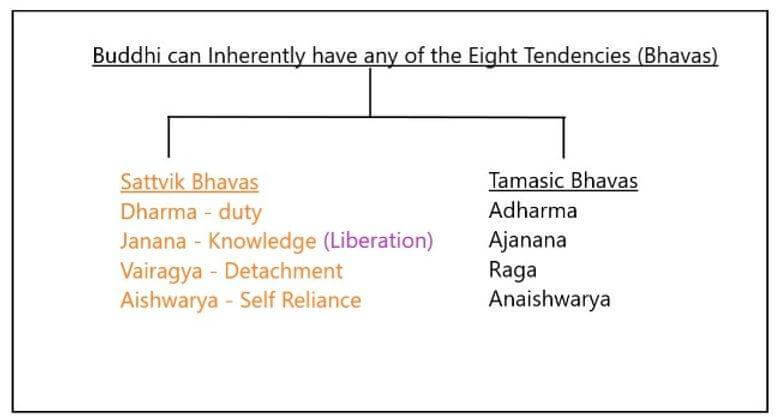Author: Randeep Singh / go to all Samkhya Karikas

Samkhya Karika 23 text:
Adhyavasayah Buddhih dharmah jnanam viragah aisvaryam |
Sattvikam etad rupam tamasam asmat viparyastam ||
Adhyavasayah – to ascertain, determine, establish
Buddhih – mahat, intellect
Dharmah – values, merit
Jnanam – wisdom, knowledge
Viragah – non-attachment
Aisvaryam – excellence of highest nature, having no match
Sattvikam – infused with purity
Etad rupam – the form of that
Tamasam – infused with inertia, laziness
Asmat – from this
Viparyastam – the opposite
It has been said that liberation results from the discriminative knowledge of the manifest (vykta) and unmanifest (avyakta), Buddhi being the first of the 23 principles of manifest. What is the nature of this Buddhi…is answered in this Samkhya karika 23.
Nature of Mahat – Buddhi | Samkhya Karika 23
The word buddhi is derived from its root ‘buddh’ that mean which awakens or which has the potential to enable an awakening. Buddhi is the first and subtlest evolute of Prakriti at the individual level. The degree of subtleness of Buddhi almost matches up with the Purusha due to which a lot many times it is taken for Purusha. The light of consciousness illuminates Buddhi due to their proximity to each other.
Buddhi is the intelligence which helps execute rationale decision making. In humans buddhi exists as the power of the will, cognition, retentive, and conative faculties. It ascertains, establishes the presence or absence of something. Like we can predict the outcome for germinating a certain seed (mango seed will only sprout into a mango plant and nothing else) from the knowledge of the attributes, or the tendencies of that seed the attributes of the decisions our intellect takes also depend on the quality and attributes of our Buddhi (intellect).
The attributes / quality of Buddhi is known as Bhava in Samkhya Philosophy. Bhavas are also known as emotions or feelings. Philosophically it means the inherent or intrinsic nature of a thing or entity, its potentiality and pre-disposition. For instance, the predisposition (bhava) of glass is to break where as that of metal is strength. Likewise, people can be inherently pre-disposed to anger, love, incompetence, greed etc.
Knowledge comes from Buddhi (intellect), from where develop the thoughts, which have to potential to either or not further transform into ego, disturbance of mind and delusion. Man’s life depends on the level and type of its intelligence or Buddhi as it has been found to remain inherently colored in any one of the tendencies (bhava) out of the eight recognized tendencies: four illuminating and four dark in nature. Duties, knowledge, detachment, and self-reliance (Dharma, Jnana, Vairagya, and Aiswarya) are illuminating (satvik) in nature, and the tendencies (Bhavas) opposite to these four are darker (tamasic) in nature.
The type of the bhava Buddhi is inherently carrying with it determines the pre-disposition man’s faculties of intellection, judgment, problem solving, and rationality will carry in them. Bhavas are like the colored filters on the viewing glasses which impart their color to anything that is seen through these glasses. The important nature of bhava is its capacity to undergo transformation.
What, when, where and how we do things is decided by our intelligence and on that depends our bondage or liberation. As per Samkhya Philosophy the ultimate purpose of the existence of man is to evolve its consciousness to its full potential through self-development. All individuals, at any stage in life possess certain characteristic qualities of Buddhi (intelligence) which may or may not be conducive to self-development. These form their basic nature, potentiality, pre-disposition or bhava.
Jnana, one of the eight attitudes (bhavas) of the Buddhi, is produced by sattva predominant Prakriti, and has the ability to discriminate between pure consciousness and matter and thus liberates. But the other seven attitudes (bhavas) of Buddhi binds us. Samkhya karika 23 encourages the development of the four illuminating bhavas of Dharma, Janana, Vairagya, and Aiswarya which aids in individual self-growth.
The illuminating bhavas, if associated with Buddhi (intelligence), enables one to recognize one’s potential of growth and the shortcomings in the path of personal development. This way we can work on our shortcomings wherever possible and plan our self-growth accordingly. Such a Buddhi can give us the right knowledge of the working of our mind, intelligence, and ego. This karika further prompts us to simultaneously reduce / eliminate the four darker (tamasic) bhavas of Adharma, Ajnana, Raga (attachment), and Aishwarya.
